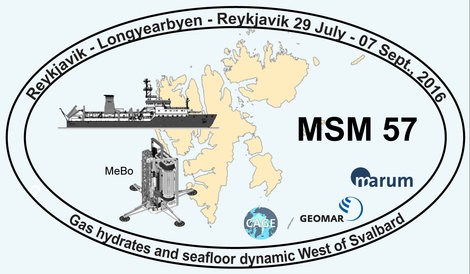Page path:
- Home
- Research
- Expeditions
- 2016
- MSM 57-2
RV Maria S. Merian MSM 57-2: 13.08.-07.09.2016 (Longyearbyen-Reykjavik)
Gas Hydrate Dynamics at Svalbard-Continental Margin - MeBo-Drillings in the Outcrop Area of the Gas Hydrate Zone
At the uppermost part of the continental slope, above the gas hydrate stability zone, various methane emission sites were detected as acoustic plumes in echosounder recordings. New investigations by Westbrook et al. (2009) interprete the gas emission by methane from hydrate decomposition due to an increase in water temperature of 1°C during the past 30 years which causes a downward movement of the upper boundary of the gas hydrate stability zone by 38 m. Latest geophysical and geochemical data give a hint, but because of the seafloor's character it was impossible to prove so far that gas hydrate dissolution is the source of the escaping gas. We are planning to drill 5 double boreholes using the mobile drilling sytem MeBo to sample hydrates for the first time in this area. Chemical analyses of the samples and physical parameters will be measured and will allow to define the phase boundary very precisely.
Bathymetric profile in the area of gas hydrate outcrop zone with planned drilling locations and modelled gas hydrate stability zone limit, at a regular temperature increase around 1°C for 30 years.

Contact and Chief Scientist:
Gerhard Bohrmann
Phone: +49 421 218 - 65051
Mail: [Bitte aktivieren Sie Javascript]
The quadrangle in this map shows the area of the planned drilling locations at western Svalbard continental margin.
MSM 57-2: Drilling cruise with MeBo
in cooperation with Christian Berndt
(GEOMAR, Kiel)
Current position of M.S. MERIAN
RV M.S. MERIAN with Control Station German Research Vessels
MeBo Drill Rig
Seismic profile (see map of locations above) across the lower continental slope (Vanneste et al. 2005).


